Organisational Behaviour Report: 4Com plc and Leadership Theories
VerifiedAdded on 2020/10/23
|17
|5140
|472
Report
AI Summary
This report delves into the realm of organisational behaviour, using 4Com plc as a case study to analyze various aspects of workplace dynamics. The introduction defines organisational behaviour and its significance in fostering a positive and productive environment. Task 1 examines the influence of organisational culture, politics, and power on individual and team behaviour, focusing on 4Com plc's approach to power, role, task, and person cultures, and the impacts of organisational politics. Task 2 evaluates motivation theories and techniques, specifically Maslow's Hierarchy of Needs and Herzberg's Two-Factor Theory, and their application within 4Com plc to achieve organisational goals. The report also covers what makes an effective team as opposed to an ineffective one. The report concludes with an application of organisational behaviour concepts and philosophies to real-world scenarios within the company. The report provides a comprehensive overview of organisational behaviour principles and their practical application in a business context.
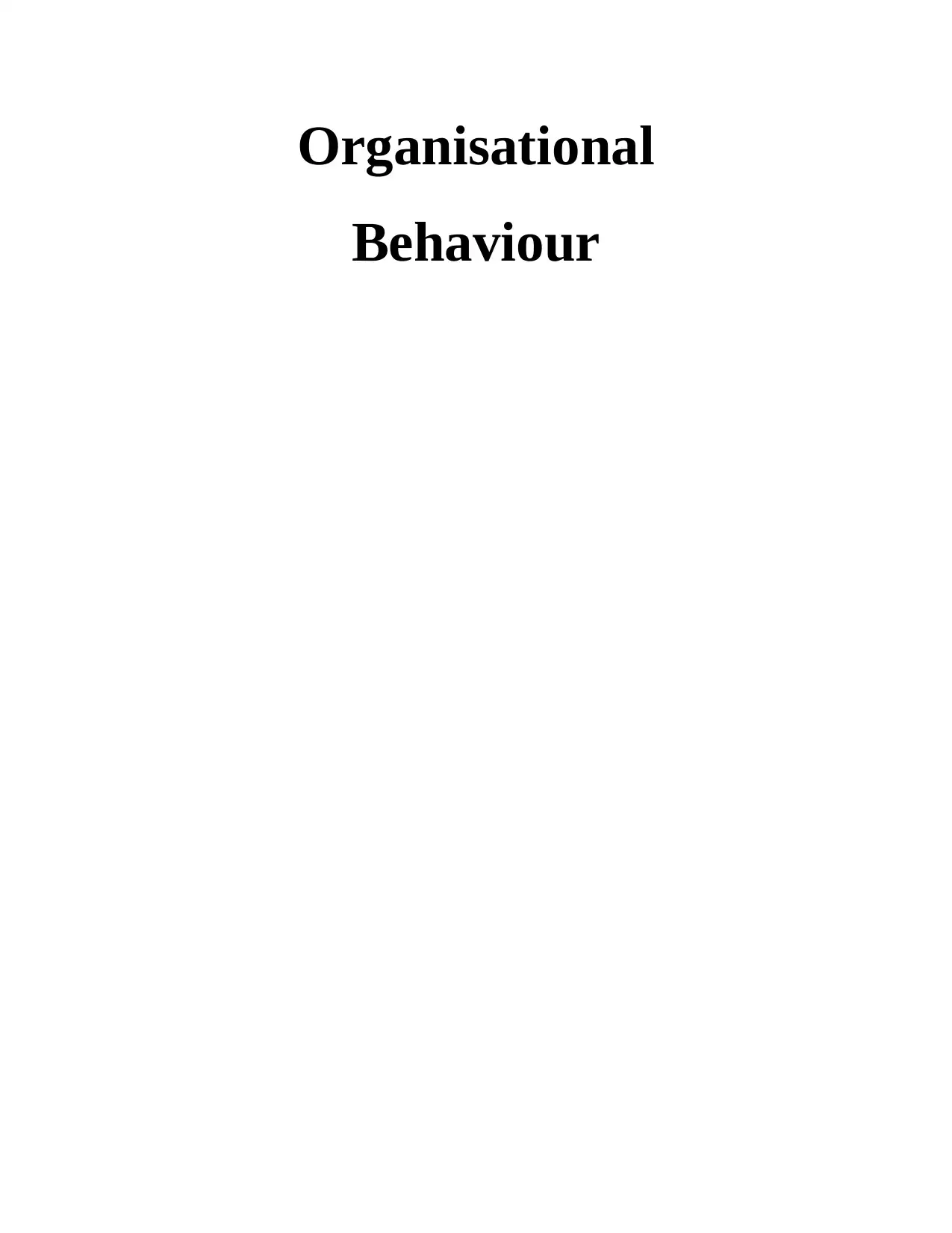
Organisational
Behaviour
Behaviour
Paraphrase This Document
Need a fresh take? Get an instant paraphrase of this document with our AI Paraphraser
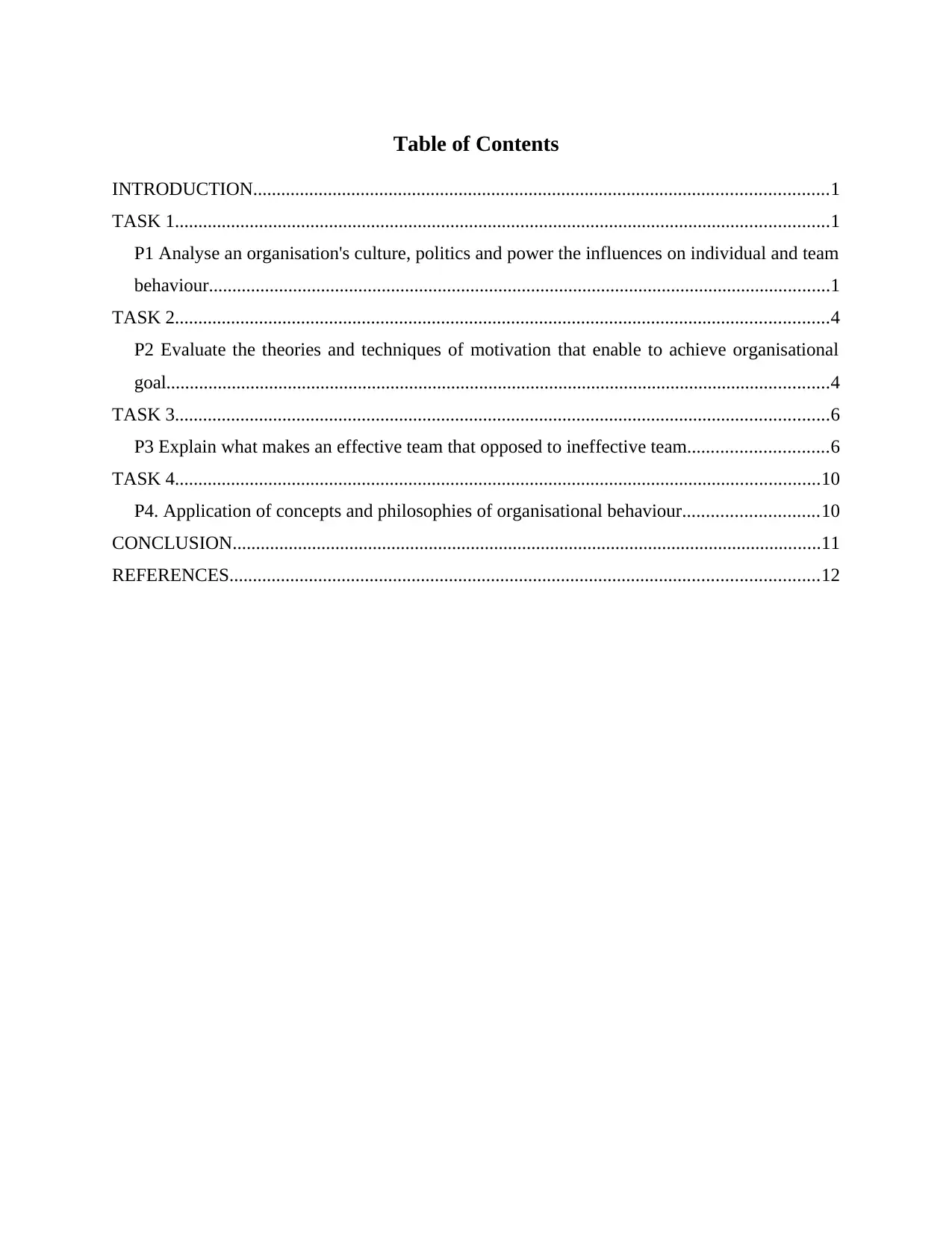
Table of Contents
INTRODUCTION...........................................................................................................................1
TASK 1............................................................................................................................................1
P1 Analyse an organisation's culture, politics and power the influences on individual and team
behaviour.....................................................................................................................................1
TASK 2............................................................................................................................................4
P2 Evaluate the theories and techniques of motivation that enable to achieve organisational
goal..............................................................................................................................................4
TASK 3............................................................................................................................................6
P3 Explain what makes an effective team that opposed to ineffective team..............................6
TASK 4..........................................................................................................................................10
P4. Application of concepts and philosophies of organisational behaviour.............................10
CONCLUSION..............................................................................................................................11
REFERENCES..............................................................................................................................12
INTRODUCTION...........................................................................................................................1
TASK 1............................................................................................................................................1
P1 Analyse an organisation's culture, politics and power the influences on individual and team
behaviour.....................................................................................................................................1
TASK 2............................................................................................................................................4
P2 Evaluate the theories and techniques of motivation that enable to achieve organisational
goal..............................................................................................................................................4
TASK 3............................................................................................................................................6
P3 Explain what makes an effective team that opposed to ineffective team..............................6
TASK 4..........................................................................................................................................10
P4. Application of concepts and philosophies of organisational behaviour.............................10
CONCLUSION..............................................................................................................................11
REFERENCES..............................................................................................................................12

⊘ This is a preview!⊘
Do you want full access?
Subscribe today to unlock all pages.

Trusted by 1+ million students worldwide
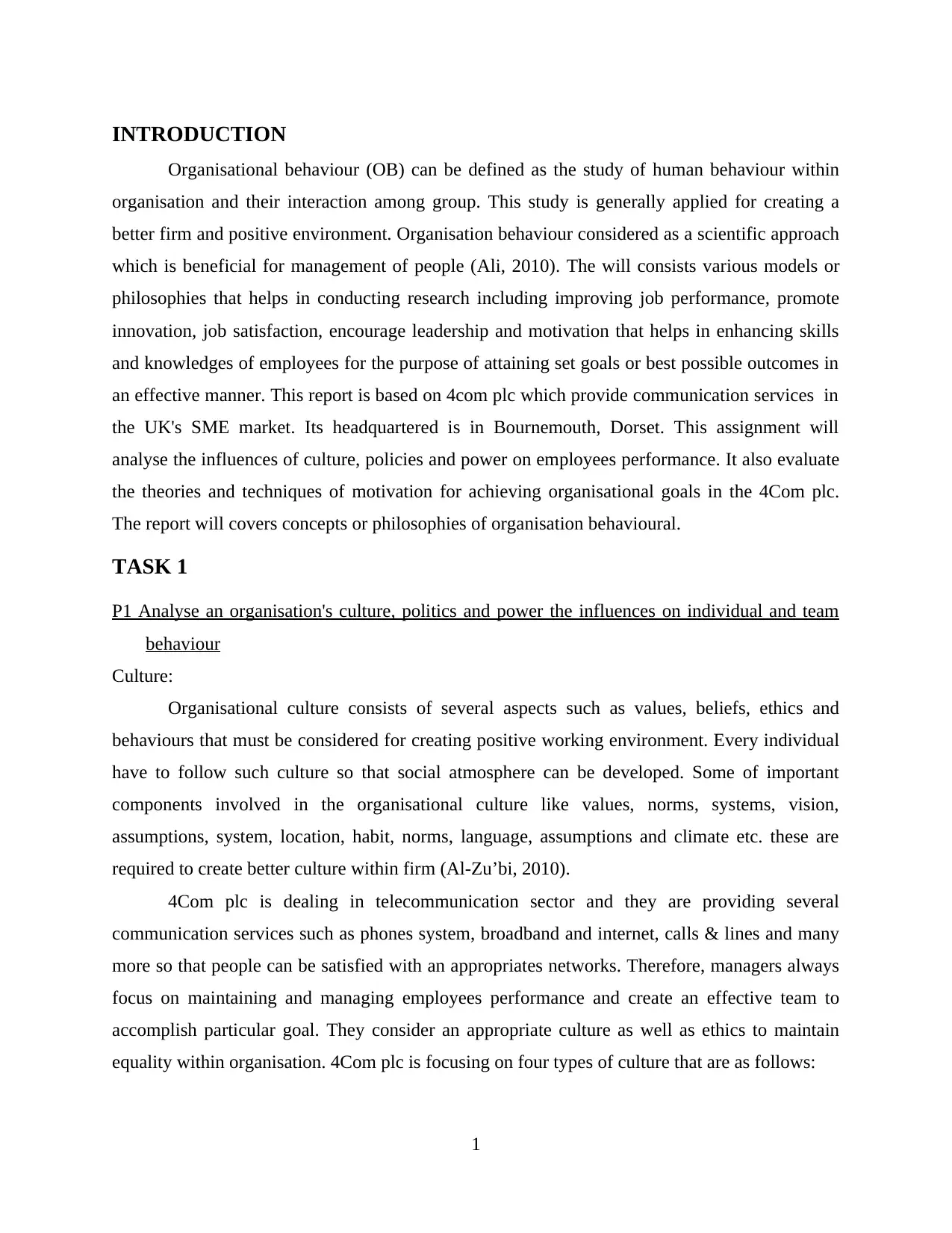
INTRODUCTION
Organisational behaviour (OB) can be defined as the study of human behaviour within
organisation and their interaction among group. This study is generally applied for creating a
better firm and positive environment. Organisation behaviour considered as a scientific approach
which is beneficial for management of people (Ali, 2010). The will consists various models or
philosophies that helps in conducting research including improving job performance, promote
innovation, job satisfaction, encourage leadership and motivation that helps in enhancing skills
and knowledges of employees for the purpose of attaining set goals or best possible outcomes in
an effective manner. This report is based on 4com plc which provide communication services in
the UK's SME market. Its headquartered is in Bournemouth, Dorset. This assignment will
analyse the influences of culture, policies and power on employees performance. It also evaluate
the theories and techniques of motivation for achieving organisational goals in the 4Com plc.
The report will covers concepts or philosophies of organisation behavioural.
TASK 1
P1 Analyse an organisation's culture, politics and power the influences on individual and team
behaviour
Culture:
Organisational culture consists of several aspects such as values, beliefs, ethics and
behaviours that must be considered for creating positive working environment. Every individual
have to follow such culture so that social atmosphere can be developed. Some of important
components involved in the organisational culture like values, norms, systems, vision,
assumptions, system, location, habit, norms, language, assumptions and climate etc. these are
required to create better culture within firm (Al-Zu’bi, 2010).
4Com plc is dealing in telecommunication sector and they are providing several
communication services such as phones system, broadband and internet, calls & lines and many
more so that people can be satisfied with an appropriates networks. Therefore, managers always
focus on maintaining and managing employees performance and create an effective team to
accomplish particular goal. They consider an appropriate culture as well as ethics to maintain
equality within organisation. 4Com plc is focusing on four types of culture that are as follows:
1
Organisational behaviour (OB) can be defined as the study of human behaviour within
organisation and their interaction among group. This study is generally applied for creating a
better firm and positive environment. Organisation behaviour considered as a scientific approach
which is beneficial for management of people (Ali, 2010). The will consists various models or
philosophies that helps in conducting research including improving job performance, promote
innovation, job satisfaction, encourage leadership and motivation that helps in enhancing skills
and knowledges of employees for the purpose of attaining set goals or best possible outcomes in
an effective manner. This report is based on 4com plc which provide communication services in
the UK's SME market. Its headquartered is in Bournemouth, Dorset. This assignment will
analyse the influences of culture, policies and power on employees performance. It also evaluate
the theories and techniques of motivation for achieving organisational goals in the 4Com plc.
The report will covers concepts or philosophies of organisation behavioural.
TASK 1
P1 Analyse an organisation's culture, politics and power the influences on individual and team
behaviour
Culture:
Organisational culture consists of several aspects such as values, beliefs, ethics and
behaviours that must be considered for creating positive working environment. Every individual
have to follow such culture so that social atmosphere can be developed. Some of important
components involved in the organisational culture like values, norms, systems, vision,
assumptions, system, location, habit, norms, language, assumptions and climate etc. these are
required to create better culture within firm (Al-Zu’bi, 2010).
4Com plc is dealing in telecommunication sector and they are providing several
communication services such as phones system, broadband and internet, calls & lines and many
more so that people can be satisfied with an appropriates networks. Therefore, managers always
focus on maintaining and managing employees performance and create an effective team to
accomplish particular goal. They consider an appropriate culture as well as ethics to maintain
equality within organisation. 4Com plc is focusing on four types of culture that are as follows:
1
Paraphrase This Document
Need a fresh take? Get an instant paraphrase of this document with our AI Paraphraser

Power culture: In this, includes the distribution of power and authorities among
employees within firm. This is essential for organising better culture and build good
relations between employees and management of the organisation. It helps in
performing entire activities by every individual as per the assigned task and given
authority (Ayyagari, Grover and Purvis, R., 2011). There is required to delegate power
as well as authorities to the employees for improving their performances and achieve
business goals in well manner.
Role Culture: It describe the major roles and responsibilities of employees in the
organisation which helps in achieving possible outcomes through completing every task
in better way. It is the main duty of manager of 4Com plc that to define the roles of
every employees towards organisation so that they can clearly understand about their
work and helps in removing any confusion regarding task. There are various benefits of
role culture as it provide opportunities to the workers for performing best and achieve
set goals or targets in well manner.
Task Culture: In this function, manager try to build an effective team for performing
particular job and complete task within time frame. This is a helpful aspect for resolving
issues or complexities with ultimate solution. Therefore, organisations can solve its
major issue by identifying this on time so that team performances can be improved.
Person culture: In this, manager always focus on every individual and take
responsibility to develop them by provide effective training and development program
for enhancing their skills, knowledges and abilities to perform better and achieve
predetermined objectives. They also consider the motivational factors which helps
maintaining performance and coordination within organisation.
Hofstede’s dimensions of culture -
Power Distance Index (high versus low)- It is referred to the value or degree of
inequality that exists and is accepted between the people which have power and no
power at all. High degree of PDI indicates hierarchical distribution of power and vice
versa.
Individualism Versus Collectivism- It can be described as a strength of interpersonal
connection that people with other people of their team or community. High IVC score
2
employees within firm. This is essential for organising better culture and build good
relations between employees and management of the organisation. It helps in
performing entire activities by every individual as per the assigned task and given
authority (Ayyagari, Grover and Purvis, R., 2011). There is required to delegate power
as well as authorities to the employees for improving their performances and achieve
business goals in well manner.
Role Culture: It describe the major roles and responsibilities of employees in the
organisation which helps in achieving possible outcomes through completing every task
in better way. It is the main duty of manager of 4Com plc that to define the roles of
every employees towards organisation so that they can clearly understand about their
work and helps in removing any confusion regarding task. There are various benefits of
role culture as it provide opportunities to the workers for performing best and achieve
set goals or targets in well manner.
Task Culture: In this function, manager try to build an effective team for performing
particular job and complete task within time frame. This is a helpful aspect for resolving
issues or complexities with ultimate solution. Therefore, organisations can solve its
major issue by identifying this on time so that team performances can be improved.
Person culture: In this, manager always focus on every individual and take
responsibility to develop them by provide effective training and development program
for enhancing their skills, knowledges and abilities to perform better and achieve
predetermined objectives. They also consider the motivational factors which helps
maintaining performance and coordination within organisation.
Hofstede’s dimensions of culture -
Power Distance Index (high versus low)- It is referred to the value or degree of
inequality that exists and is accepted between the people which have power and no
power at all. High degree of PDI indicates hierarchical distribution of power and vice
versa.
Individualism Versus Collectivism- It can be described as a strength of interpersonal
connection that people with other people of their team or community. High IVC score
2

indicates that people have weak sense of connection with each other and does not take
responsibilities for others actions.
Masculinity Versus Femininity- This model studies the distribution of roles and
responsibilities among men and women. In masculinity society, overlapping of roles is
less, however in femininity the the overlapping of work between men and women is
more.
Uncertainty Avoidance Index (high versus low)- This model describes how well can
people cope up with anxiety and such situations. People with low UAI score are more
open and relaxed.
Pragmatic Versus Normative- This dimension is refer to the degree of people
explaining the unexplainable. It is primly related to nationalism and religiosity. As this
methodology was added recently, a depth data is still not available.
Indulgence Versus Restraint- This dimension refers to two different aspects as high or
low. High IVR score allows people to live their life freely and having fun whereas, Low
IVR determine more regulation of people's conduct and behaviour, and there are stricter
social norms.
The culture which is followed by the management of 4Com Plc is role culture. This will
helps the organisation is to attain their objectives within given framework of time through
effective disbursement of role to the employees according to their working nature.
Politics:
Organisational politics is related with informal efforts for the purpose of sharing, ideas,
increase powers that have major impacts on the organisational goals (Baum, Frese and Baron,
2014) . It can be seen in various companies as they generally do the same for generating their
power and improving image among other employees. This factor can create critical situations
regarding partiality between workers and demotivate them to work effectively. There are some
major impacts of politics on individual and team such as:
Reduce level of productivity: This is a major issue of politics because it directly affects
the work productivity of employees which can be harmed due to partiality. It can be
measured by reviewing of performances as some of employees use office politics for
getting higher position within organisation. So, this can effect other workers
3
responsibilities for others actions.
Masculinity Versus Femininity- This model studies the distribution of roles and
responsibilities among men and women. In masculinity society, overlapping of roles is
less, however in femininity the the overlapping of work between men and women is
more.
Uncertainty Avoidance Index (high versus low)- This model describes how well can
people cope up with anxiety and such situations. People with low UAI score are more
open and relaxed.
Pragmatic Versus Normative- This dimension is refer to the degree of people
explaining the unexplainable. It is primly related to nationalism and religiosity. As this
methodology was added recently, a depth data is still not available.
Indulgence Versus Restraint- This dimension refers to two different aspects as high or
low. High IVR score allows people to live their life freely and having fun whereas, Low
IVR determine more regulation of people's conduct and behaviour, and there are stricter
social norms.
The culture which is followed by the management of 4Com Plc is role culture. This will
helps the organisation is to attain their objectives within given framework of time through
effective disbursement of role to the employees according to their working nature.
Politics:
Organisational politics is related with informal efforts for the purpose of sharing, ideas,
increase powers that have major impacts on the organisational goals (Baum, Frese and Baron,
2014) . It can be seen in various companies as they generally do the same for generating their
power and improving image among other employees. This factor can create critical situations
regarding partiality between workers and demotivate them to work effectively. There are some
major impacts of politics on individual and team such as:
Reduce level of productivity: This is a major issue of politics because it directly affects
the work productivity of employees which can be harmed due to partiality. It can be
measured by reviewing of performances as some of employees use office politics for
getting higher position within organisation. So, this can effect other workers
3
⊘ This is a preview!⊘
Do you want full access?
Subscribe today to unlock all pages.

Trusted by 1+ million students worldwide
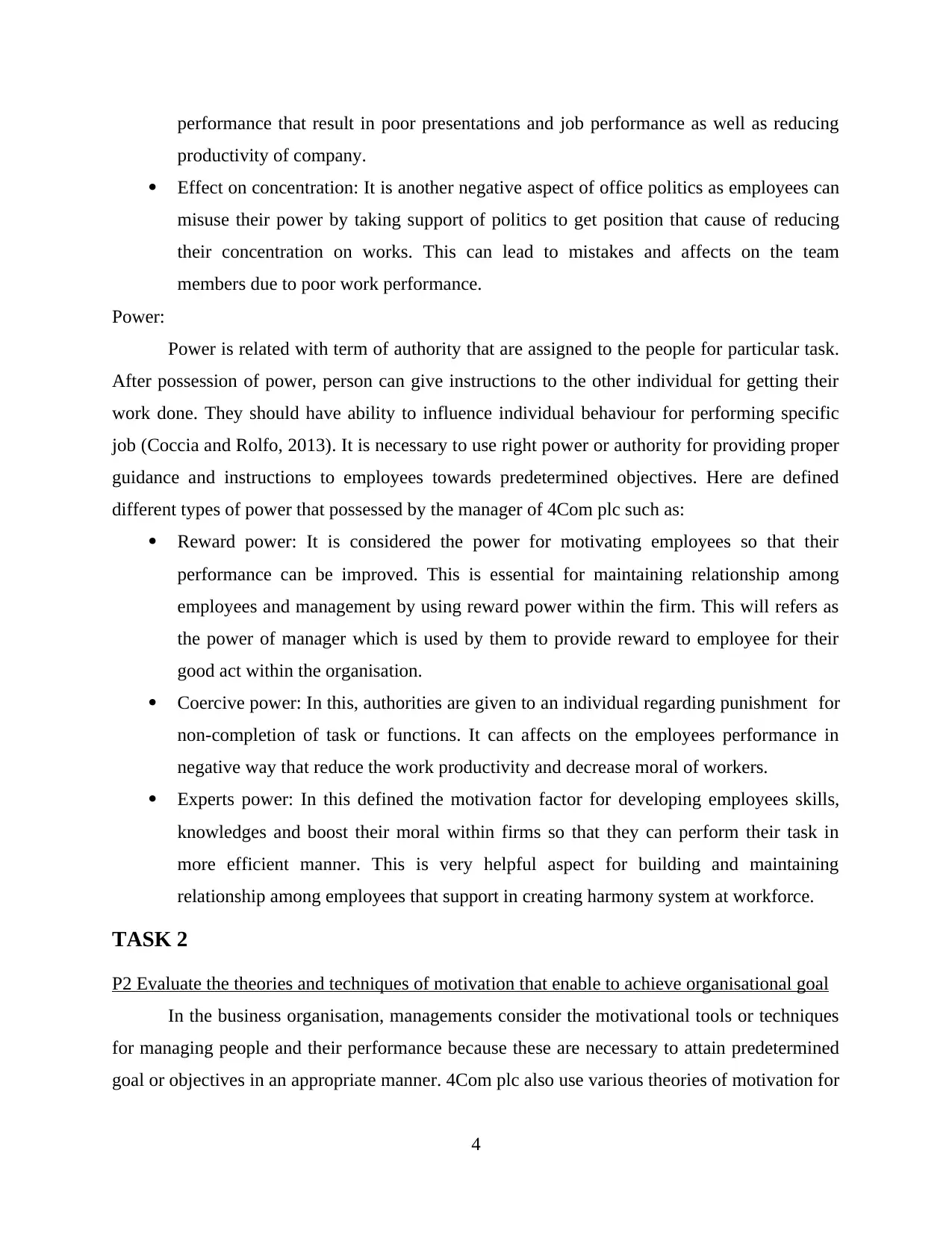
performance that result in poor presentations and job performance as well as reducing
productivity of company.
Effect on concentration: It is another negative aspect of office politics as employees can
misuse their power by taking support of politics to get position that cause of reducing
their concentration on works. This can lead to mistakes and affects on the team
members due to poor work performance.
Power:
Power is related with term of authority that are assigned to the people for particular task.
After possession of power, person can give instructions to the other individual for getting their
work done. They should have ability to influence individual behaviour for performing specific
job (Coccia and Rolfo, 2013). It is necessary to use right power or authority for providing proper
guidance and instructions to employees towards predetermined objectives. Here are defined
different types of power that possessed by the manager of 4Com plc such as:
Reward power: It is considered the power for motivating employees so that their
performance can be improved. This is essential for maintaining relationship among
employees and management by using reward power within the firm. This will refers as
the power of manager which is used by them to provide reward to employee for their
good act within the organisation.
Coercive power: In this, authorities are given to an individual regarding punishment for
non-completion of task or functions. It can affects on the employees performance in
negative way that reduce the work productivity and decrease moral of workers.
Experts power: In this defined the motivation factor for developing employees skills,
knowledges and boost their moral within firms so that they can perform their task in
more efficient manner. This is very helpful aspect for building and maintaining
relationship among employees that support in creating harmony system at workforce.
TASK 2
P2 Evaluate the theories and techniques of motivation that enable to achieve organisational goal
In the business organisation, managements consider the motivational tools or techniques
for managing people and their performance because these are necessary to attain predetermined
goal or objectives in an appropriate manner. 4Com plc also use various theories of motivation for
4
productivity of company.
Effect on concentration: It is another negative aspect of office politics as employees can
misuse their power by taking support of politics to get position that cause of reducing
their concentration on works. This can lead to mistakes and affects on the team
members due to poor work performance.
Power:
Power is related with term of authority that are assigned to the people for particular task.
After possession of power, person can give instructions to the other individual for getting their
work done. They should have ability to influence individual behaviour for performing specific
job (Coccia and Rolfo, 2013). It is necessary to use right power or authority for providing proper
guidance and instructions to employees towards predetermined objectives. Here are defined
different types of power that possessed by the manager of 4Com plc such as:
Reward power: It is considered the power for motivating employees so that their
performance can be improved. This is essential for maintaining relationship among
employees and management by using reward power within the firm. This will refers as
the power of manager which is used by them to provide reward to employee for their
good act within the organisation.
Coercive power: In this, authorities are given to an individual regarding punishment for
non-completion of task or functions. It can affects on the employees performance in
negative way that reduce the work productivity and decrease moral of workers.
Experts power: In this defined the motivation factor for developing employees skills,
knowledges and boost their moral within firms so that they can perform their task in
more efficient manner. This is very helpful aspect for building and maintaining
relationship among employees that support in creating harmony system at workforce.
TASK 2
P2 Evaluate the theories and techniques of motivation that enable to achieve organisational goal
In the business organisation, managements consider the motivational tools or techniques
for managing people and their performance because these are necessary to attain predetermined
goal or objectives in an appropriate manner. 4Com plc also use various theories of motivation for
4
Paraphrase This Document
Need a fresh take? Get an instant paraphrase of this document with our AI Paraphraser

satisfy employees. There are two types of theories as content and process that helps in bringing
effectiveness within an organisation (DeChurch and Mesmer-Magnus, 2010). Content provide
various factors that are related with individual and influence their behaviours in an effective
ways. These theories are helpful in identifying the basic needs and desired of employees so that
management can fulfil those to satisfy them. It is necessary to identify and determine their
demands to motivate them effectively. 4Com plc generally consider two motivational theories
such as Maslow and Herzberg's two factor theory. These are as following:
Maslow's Hierarchy Theory: This theory was introduced by Abraham Maslow for the
purpose of identification of basic needs of employees and satisfy them with appropriate manner.
It has been categorised into five major areas which describe the different level of motivation
within the firm. These are as following:
Physiological needs: In this considered basic needs of people including air, shelter, water,
cloths, foods and other components. These are some necessary aspects that needed to
survive in human life. Employees should be motivated within organisation by fulfilling
their necessities and basic requirements as well.
Safety needs: In this defined various aspects which related safety and security of people.
Management have to provide safety to their employees so that they can be satisfied in
adequate manner (Haslam and et.al., 2014). In this includes job safety, health and safety
majors, and financial securities to create positive working environment.
Social needs: It explain different kinds of needs including love, belongingness, care,
affection or attraction, and friendship. These are very important for every organisation as
they can develop the workforce, build good relations, positive working environment, and
better culture within organisation.
Esteem needs: It can be classified into two categories such as internals and external needs
of people for motivation. Internal esteem needs consider self-respect, freedom and
confidence as well as external involves power, status, and recognition for motivation.
Self-actualization needs: In this required proper needs regarding development of self-
contentment and their growth (Hershcovis, 2011). Employees generally wants to enhance
their skills, knowledges and abilities for developing personalities. They also focus on
getting social services, effectiveness and creativity for the purpose of improving
performance and attain predetermined goals in well manner.
5
effectiveness within an organisation (DeChurch and Mesmer-Magnus, 2010). Content provide
various factors that are related with individual and influence their behaviours in an effective
ways. These theories are helpful in identifying the basic needs and desired of employees so that
management can fulfil those to satisfy them. It is necessary to identify and determine their
demands to motivate them effectively. 4Com plc generally consider two motivational theories
such as Maslow and Herzberg's two factor theory. These are as following:
Maslow's Hierarchy Theory: This theory was introduced by Abraham Maslow for the
purpose of identification of basic needs of employees and satisfy them with appropriate manner.
It has been categorised into five major areas which describe the different level of motivation
within the firm. These are as following:
Physiological needs: In this considered basic needs of people including air, shelter, water,
cloths, foods and other components. These are some necessary aspects that needed to
survive in human life. Employees should be motivated within organisation by fulfilling
their necessities and basic requirements as well.
Safety needs: In this defined various aspects which related safety and security of people.
Management have to provide safety to their employees so that they can be satisfied in
adequate manner (Haslam and et.al., 2014). In this includes job safety, health and safety
majors, and financial securities to create positive working environment.
Social needs: It explain different kinds of needs including love, belongingness, care,
affection or attraction, and friendship. These are very important for every organisation as
they can develop the workforce, build good relations, positive working environment, and
better culture within organisation.
Esteem needs: It can be classified into two categories such as internals and external needs
of people for motivation. Internal esteem needs consider self-respect, freedom and
confidence as well as external involves power, status, and recognition for motivation.
Self-actualization needs: In this required proper needs regarding development of self-
contentment and their growth (Hershcovis, 2011). Employees generally wants to enhance
their skills, knowledges and abilities for developing personalities. They also focus on
getting social services, effectiveness and creativity for the purpose of improving
performance and attain predetermined goals in well manner.
5
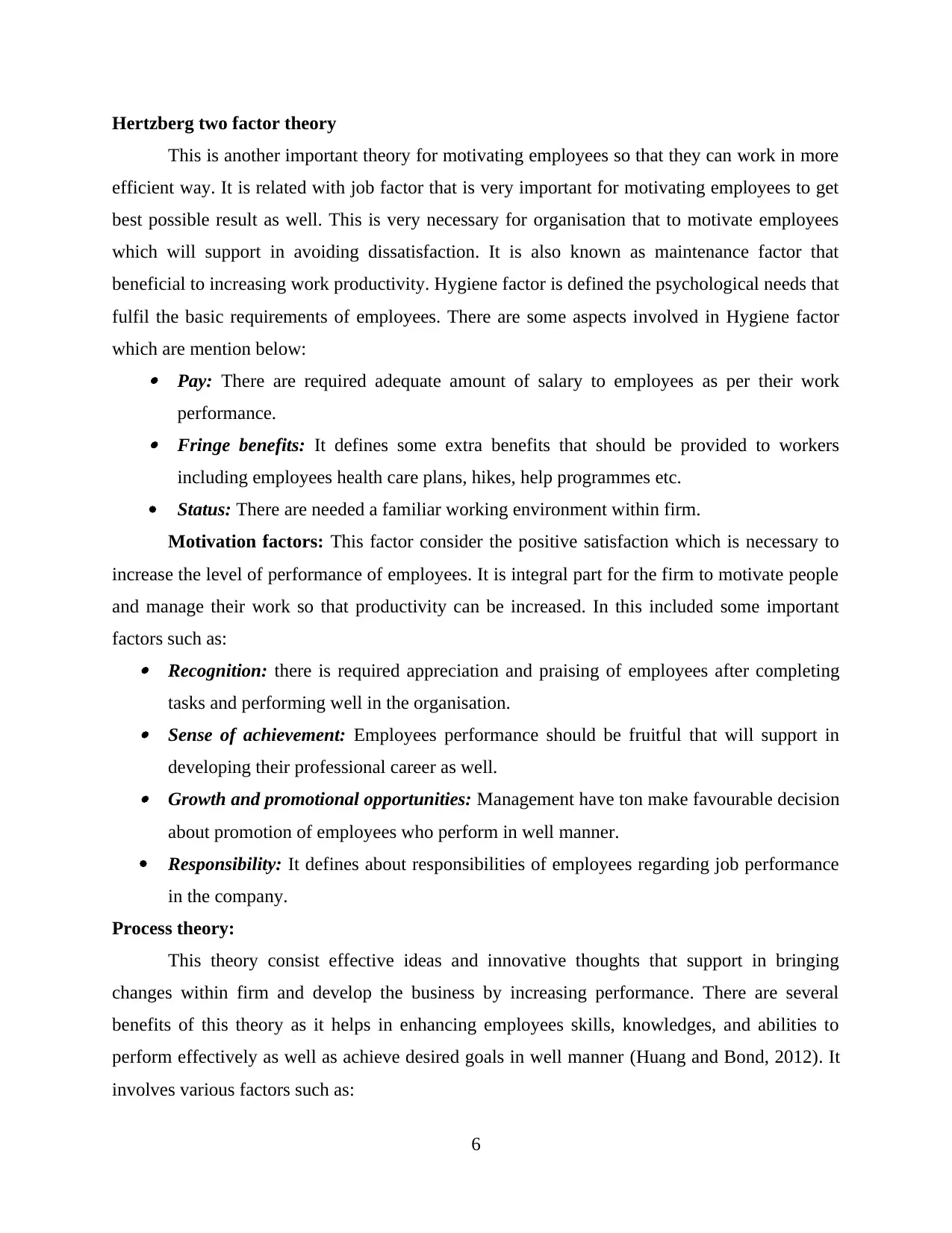
Hertzberg two factor theory
This is another important theory for motivating employees so that they can work in more
efficient way. It is related with job factor that is very important for motivating employees to get
best possible result as well. This is very necessary for organisation that to motivate employees
which will support in avoiding dissatisfaction. It is also known as maintenance factor that
beneficial to increasing work productivity. Hygiene factor is defined the psychological needs that
fulfil the basic requirements of employees. There are some aspects involved in Hygiene factor
which are mention below: Pay: There are required adequate amount of salary to employees as per their work
performance. Fringe benefits: It defines some extra benefits that should be provided to workers
including employees health care plans, hikes, help programmes etc.
Status: There are needed a familiar working environment within firm.
Motivation factors: This factor consider the positive satisfaction which is necessary to
increase the level of performance of employees. It is integral part for the firm to motivate people
and manage their work so that productivity can be increased. In this included some important
factors such as: Recognition: there is required appreciation and praising of employees after completing
tasks and performing well in the organisation. Sense of achievement: Employees performance should be fruitful that will support in
developing their professional career as well. Growth and promotional opportunities: Management have ton make favourable decision
about promotion of employees who perform in well manner.
Responsibility: It defines about responsibilities of employees regarding job performance
in the company.
Process theory:
This theory consist effective ideas and innovative thoughts that support in bringing
changes within firm and develop the business by increasing performance. There are several
benefits of this theory as it helps in enhancing employees skills, knowledges, and abilities to
perform effectively as well as achieve desired goals in well manner (Huang and Bond, 2012). It
involves various factors such as:
6
This is another important theory for motivating employees so that they can work in more
efficient way. It is related with job factor that is very important for motivating employees to get
best possible result as well. This is very necessary for organisation that to motivate employees
which will support in avoiding dissatisfaction. It is also known as maintenance factor that
beneficial to increasing work productivity. Hygiene factor is defined the psychological needs that
fulfil the basic requirements of employees. There are some aspects involved in Hygiene factor
which are mention below: Pay: There are required adequate amount of salary to employees as per their work
performance. Fringe benefits: It defines some extra benefits that should be provided to workers
including employees health care plans, hikes, help programmes etc.
Status: There are needed a familiar working environment within firm.
Motivation factors: This factor consider the positive satisfaction which is necessary to
increase the level of performance of employees. It is integral part for the firm to motivate people
and manage their work so that productivity can be increased. In this included some important
factors such as: Recognition: there is required appreciation and praising of employees after completing
tasks and performing well in the organisation. Sense of achievement: Employees performance should be fruitful that will support in
developing their professional career as well. Growth and promotional opportunities: Management have ton make favourable decision
about promotion of employees who perform in well manner.
Responsibility: It defines about responsibilities of employees regarding job performance
in the company.
Process theory:
This theory consist effective ideas and innovative thoughts that support in bringing
changes within firm and develop the business by increasing performance. There are several
benefits of this theory as it helps in enhancing employees skills, knowledges, and abilities to
perform effectively as well as achieve desired goals in well manner (Huang and Bond, 2012). It
involves various factors such as:
6
⊘ This is a preview!⊘
Do you want full access?
Subscribe today to unlock all pages.

Trusted by 1+ million students worldwide
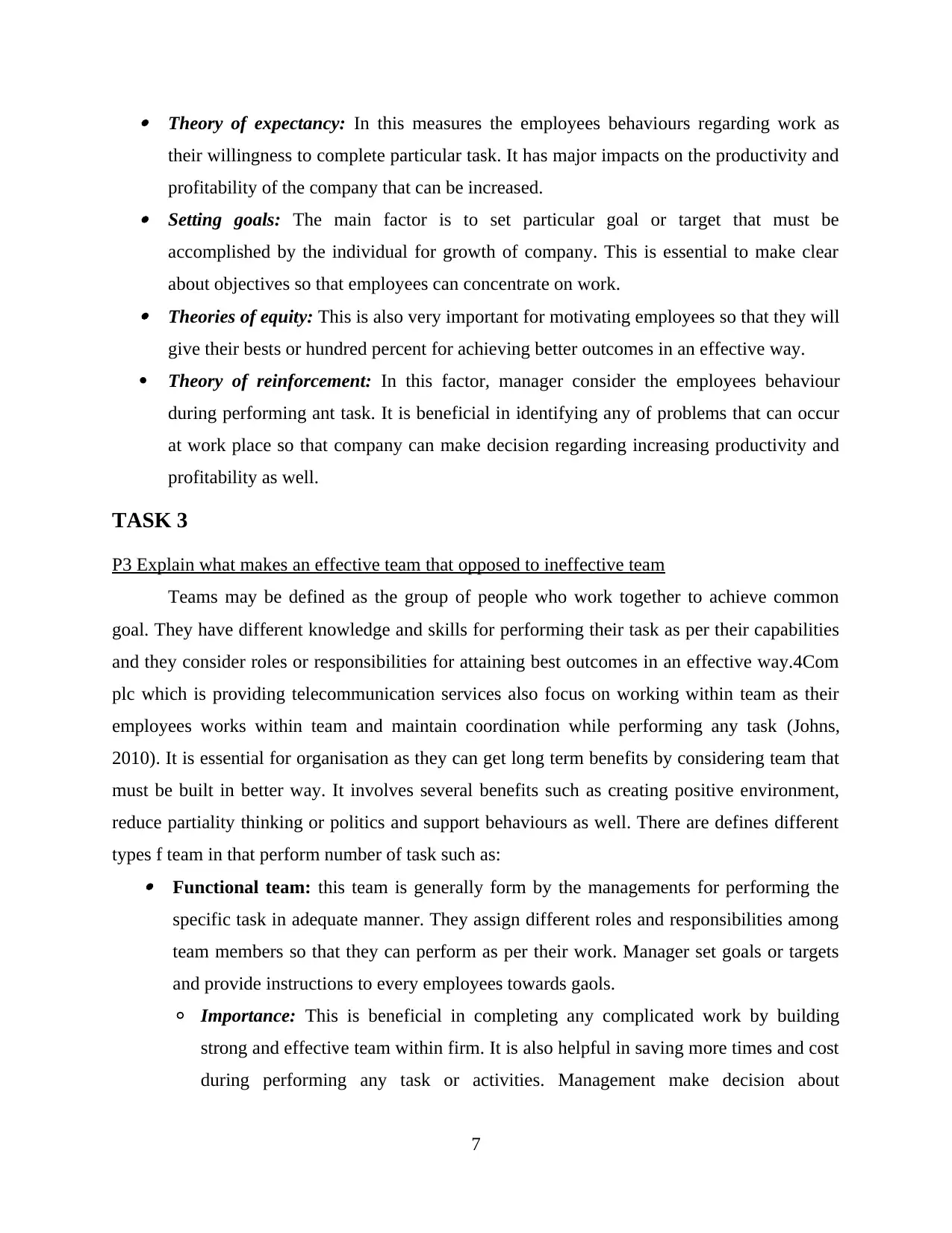
Theory of expectancy: In this measures the employees behaviours regarding work as
their willingness to complete particular task. It has major impacts on the productivity and
profitability of the company that can be increased. Setting goals: The main factor is to set particular goal or target that must be
accomplished by the individual for growth of company. This is essential to make clear
about objectives so that employees can concentrate on work. Theories of equity: This is also very important for motivating employees so that they will
give their bests or hundred percent for achieving better outcomes in an effective way.
Theory of reinforcement: In this factor, manager consider the employees behaviour
during performing ant task. It is beneficial in identifying any of problems that can occur
at work place so that company can make decision regarding increasing productivity and
profitability as well.
TASK 3
P3 Explain what makes an effective team that opposed to ineffective team
Teams may be defined as the group of people who work together to achieve common
goal. They have different knowledge and skills for performing their task as per their capabilities
and they consider roles or responsibilities for attaining best outcomes in an effective way.4Com
plc which is providing telecommunication services also focus on working within team as their
employees works within team and maintain coordination while performing any task (Johns,
2010). It is essential for organisation as they can get long term benefits by considering team that
must be built in better way. It involves several benefits such as creating positive environment,
reduce partiality thinking or politics and support behaviours as well. There are defines different
types f team in that perform number of task such as: Functional team: this team is generally form by the managements for performing the
specific task in adequate manner. They assign different roles and responsibilities among
team members so that they can perform as per their work. Manager set goals or targets
and provide instructions to every employees towards gaols.
◦ Importance: This is beneficial in completing any complicated work by building
strong and effective team within firm. It is also helpful in saving more times and cost
during performing any task or activities. Management make decision about
7
their willingness to complete particular task. It has major impacts on the productivity and
profitability of the company that can be increased. Setting goals: The main factor is to set particular goal or target that must be
accomplished by the individual for growth of company. This is essential to make clear
about objectives so that employees can concentrate on work. Theories of equity: This is also very important for motivating employees so that they will
give their bests or hundred percent for achieving better outcomes in an effective way.
Theory of reinforcement: In this factor, manager consider the employees behaviour
during performing ant task. It is beneficial in identifying any of problems that can occur
at work place so that company can make decision regarding increasing productivity and
profitability as well.
TASK 3
P3 Explain what makes an effective team that opposed to ineffective team
Teams may be defined as the group of people who work together to achieve common
goal. They have different knowledge and skills for performing their task as per their capabilities
and they consider roles or responsibilities for attaining best outcomes in an effective way.4Com
plc which is providing telecommunication services also focus on working within team as their
employees works within team and maintain coordination while performing any task (Johns,
2010). It is essential for organisation as they can get long term benefits by considering team that
must be built in better way. It involves several benefits such as creating positive environment,
reduce partiality thinking or politics and support behaviours as well. There are defines different
types f team in that perform number of task such as: Functional team: this team is generally form by the managements for performing the
specific task in adequate manner. They assign different roles and responsibilities among
team members so that they can perform as per their work. Manager set goals or targets
and provide instructions to every employees towards gaols.
◦ Importance: This is beneficial in completing any complicated work by building
strong and effective team within firm. It is also helpful in saving more times and cost
during performing any task or activities. Management make decision about
7
Paraphrase This Document
Need a fresh take? Get an instant paraphrase of this document with our AI Paraphraser
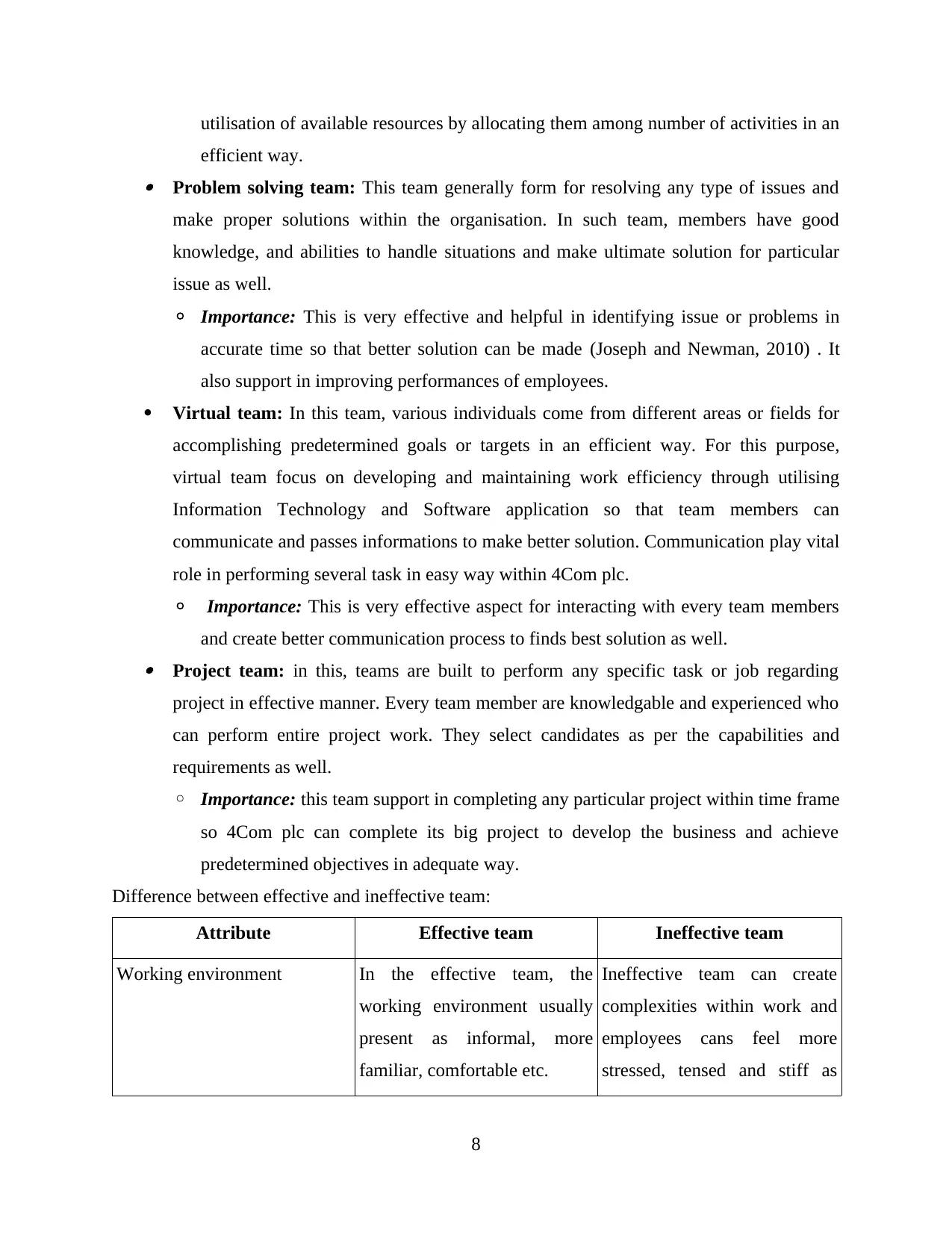
utilisation of available resources by allocating them among number of activities in an
efficient way. Problem solving team: This team generally form for resolving any type of issues and
make proper solutions within the organisation. In such team, members have good
knowledge, and abilities to handle situations and make ultimate solution for particular
issue as well.
◦ Importance: This is very effective and helpful in identifying issue or problems in
accurate time so that better solution can be made (Joseph and Newman, 2010) . It
also support in improving performances of employees.
Virtual team: In this team, various individuals come from different areas or fields for
accomplishing predetermined goals or targets in an efficient way. For this purpose,
virtual team focus on developing and maintaining work efficiency through utilising
Information Technology and Software application so that team members can
communicate and passes informations to make better solution. Communication play vital
role in performing several task in easy way within 4Com plc.
◦ Importance: This is very effective aspect for interacting with every team members
and create better communication process to finds best solution as well. Project team: in this, teams are built to perform any specific task or job regarding
project in effective manner. Every team member are knowledgable and experienced who
can perform entire project work. They select candidates as per the capabilities and
requirements as well.
◦ Importance: this team support in completing any particular project within time frame
so 4Com plc can complete its big project to develop the business and achieve
predetermined objectives in adequate way.
Difference between effective and ineffective team:
Attribute Effective team Ineffective team
Working environment In the effective team, the
working environment usually
present as informal, more
familiar, comfortable etc.
Ineffective team can create
complexities within work and
employees cans feel more
stressed, tensed and stiff as
8
efficient way. Problem solving team: This team generally form for resolving any type of issues and
make proper solutions within the organisation. In such team, members have good
knowledge, and abilities to handle situations and make ultimate solution for particular
issue as well.
◦ Importance: This is very effective and helpful in identifying issue or problems in
accurate time so that better solution can be made (Joseph and Newman, 2010) . It
also support in improving performances of employees.
Virtual team: In this team, various individuals come from different areas or fields for
accomplishing predetermined goals or targets in an efficient way. For this purpose,
virtual team focus on developing and maintaining work efficiency through utilising
Information Technology and Software application so that team members can
communicate and passes informations to make better solution. Communication play vital
role in performing several task in easy way within 4Com plc.
◦ Importance: This is very effective aspect for interacting with every team members
and create better communication process to finds best solution as well. Project team: in this, teams are built to perform any specific task or job regarding
project in effective manner. Every team member are knowledgable and experienced who
can perform entire project work. They select candidates as per the capabilities and
requirements as well.
◦ Importance: this team support in completing any particular project within time frame
so 4Com plc can complete its big project to develop the business and achieve
predetermined objectives in adequate way.
Difference between effective and ineffective team:
Attribute Effective team Ineffective team
Working environment In the effective team, the
working environment usually
present as informal, more
familiar, comfortable etc.
Ineffective team can create
complexities within work and
employees cans feel more
stressed, tensed and stiff as
8
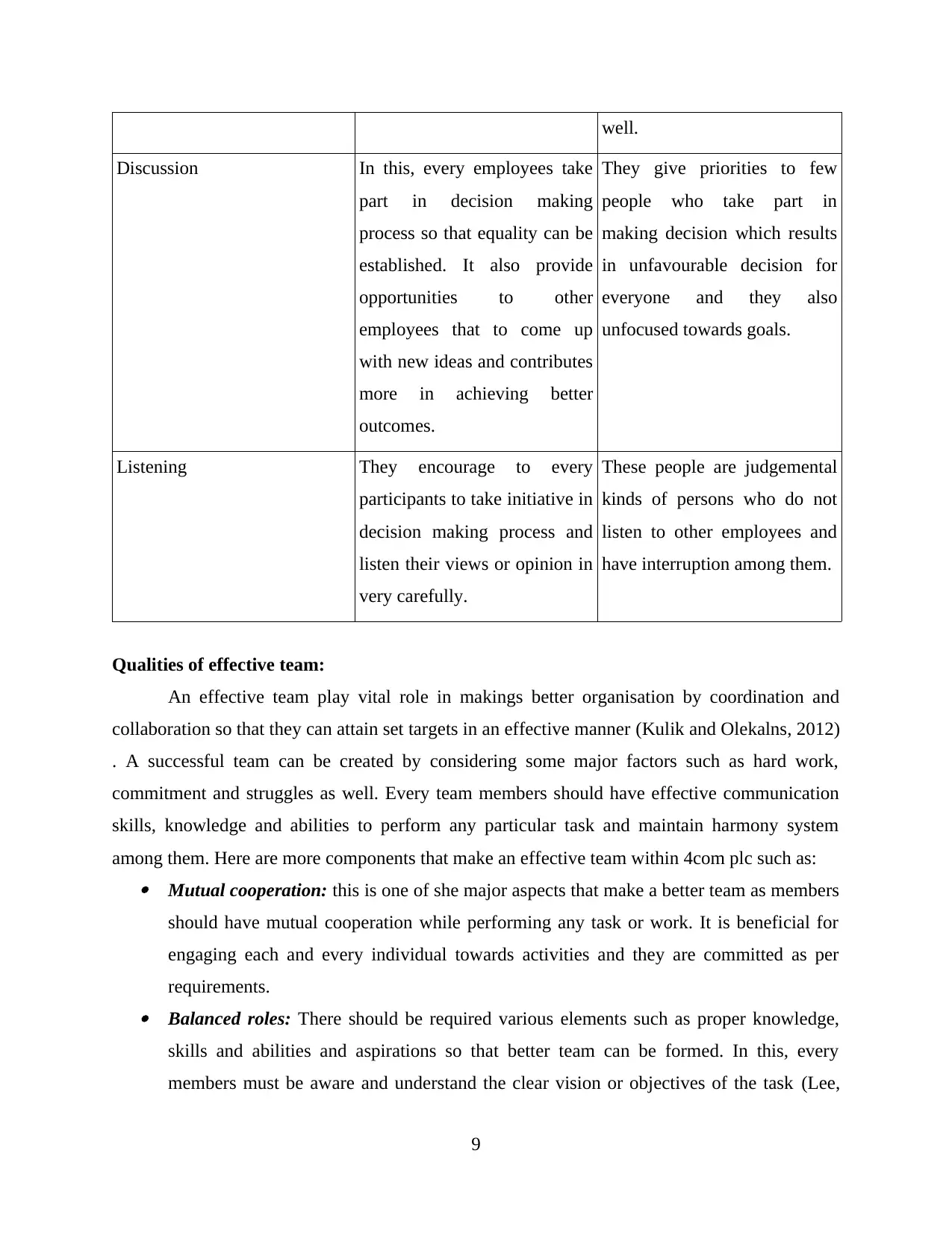
well.
Discussion In this, every employees take
part in decision making
process so that equality can be
established. It also provide
opportunities to other
employees that to come up
with new ideas and contributes
more in achieving better
outcomes.
They give priorities to few
people who take part in
making decision which results
in unfavourable decision for
everyone and they also
unfocused towards goals.
Listening They encourage to every
participants to take initiative in
decision making process and
listen their views or opinion in
very carefully.
These people are judgemental
kinds of persons who do not
listen to other employees and
have interruption among them.
Qualities of effective team:
An effective team play vital role in makings better organisation by coordination and
collaboration so that they can attain set targets in an effective manner (Kulik and Olekalns, 2012)
. A successful team can be created by considering some major factors such as hard work,
commitment and struggles as well. Every team members should have effective communication
skills, knowledge and abilities to perform any particular task and maintain harmony system
among them. Here are more components that make an effective team within 4com plc such as: Mutual cooperation: this is one of she major aspects that make a better team as members
should have mutual cooperation while performing any task or work. It is beneficial for
engaging each and every individual towards activities and they are committed as per
requirements. Balanced roles: There should be required various elements such as proper knowledge,
skills and abilities and aspirations so that better team can be formed. In this, every
members must be aware and understand the clear vision or objectives of the task (Lee,
9
Discussion In this, every employees take
part in decision making
process so that equality can be
established. It also provide
opportunities to other
employees that to come up
with new ideas and contributes
more in achieving better
outcomes.
They give priorities to few
people who take part in
making decision which results
in unfavourable decision for
everyone and they also
unfocused towards goals.
Listening They encourage to every
participants to take initiative in
decision making process and
listen their views or opinion in
very carefully.
These people are judgemental
kinds of persons who do not
listen to other employees and
have interruption among them.
Qualities of effective team:
An effective team play vital role in makings better organisation by coordination and
collaboration so that they can attain set targets in an effective manner (Kulik and Olekalns, 2012)
. A successful team can be created by considering some major factors such as hard work,
commitment and struggles as well. Every team members should have effective communication
skills, knowledge and abilities to perform any particular task and maintain harmony system
among them. Here are more components that make an effective team within 4com plc such as: Mutual cooperation: this is one of she major aspects that make a better team as members
should have mutual cooperation while performing any task or work. It is beneficial for
engaging each and every individual towards activities and they are committed as per
requirements. Balanced roles: There should be required various elements such as proper knowledge,
skills and abilities and aspirations so that better team can be formed. In this, every
members must be aware and understand the clear vision or objectives of the task (Lee,
9
⊘ This is a preview!⊘
Do you want full access?
Subscribe today to unlock all pages.

Trusted by 1+ million students worldwide
1 out of 17
Related Documents
Your All-in-One AI-Powered Toolkit for Academic Success.
+13062052269
info@desklib.com
Available 24*7 on WhatsApp / Email
![[object Object]](/_next/static/media/star-bottom.7253800d.svg)
Unlock your academic potential
Copyright © 2020–2025 A2Z Services. All Rights Reserved. Developed and managed by ZUCOL.





